We spent ten days in Spain…
Images from Gijon, Ribadeo, Viveiro… all Spain.
So much of sailing is waiting. Waiting for the wind to come down from 35kts. Waiting for the swell to be less than 15 feet. Waiting for a part to come in from somewhere. Waiting for some paperwork to be finished.
And, the shame of it is, when we are waiting on that storm system to pass, the storm system is on top of us. So our “off days” are usually accompanied by howling winds and likely not a small bit of rain.
We would be remiss, though, if we just sat on our hands and did nothing. In some of the more remote, exotic locations in Western Europe, we can find some really fascinating, un-touristy places. When you’re arriving on a boat, you come in through the back door. Tourists, arriving by car or train or plane, arrive to the billboards and manicured shrubbery and freshly planted flowers out of season. The ports are usually in the old section of town that smells of fish or wet wooden decking or nothing at all. Anything that blooms comes up naturally through the cracks in the cobblestones. And, like these old paving stones – and unlike the glass and steel airport architecture – almost everything has rounded edges worn by time and proximity to the sea.
By: Noah D.
Travel will teach you things. It will teach you marvelous things. But it will also teach you to fail. Or, rather, teach you that failing is not the end of the story… let alone something to be feared.
We attempted to cross the Celtic Sea on March 14. We made it around 25 miles before turning back: the sea was not having it. Massive swells pushed us farther and farther off course. Simply tacking would only send us back up the coast. Disappointed, we turned back.
And then St.Patrick’s Day came to pass.
What began as a simple call to get tickets at the Cork Opera House for an evening of Irish music somehow turned into various people calling us back. And then we had seats with our names on them in the grand stand for the parade, which turned into access to the parade itself… followed by a brisk walk through the city to a private room in a pub and sat down beside a famous radio personality… and then the Lord Mayor of Cork. They said, “Sit here.” …and there we sat, a constant stream of people greeting the personalities and us not knowing that we were really nothing special.
We experienced St.Patrick’s Day from the inside. We saw Cork with all its dressings on and from behind the curtain.
It has occurred to me that my date stamps are wrong. It is 2015, after all…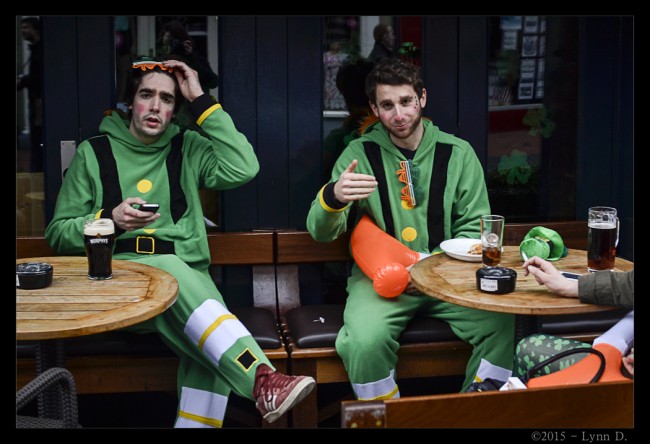
If you seat yourself next to a king, anyone can ask you to get up and move. If a king seats you next to him, only a king can move you. The world is full of people trying to get themselves seated next to a king… or look like they have been seated there. We just got blown in by the sea.
Who knows what disappointment holds? Whatever happens, it is going to be good…
By: Noah D.
Since our last post from Ramsgate, we’ve been clocking up the mileage. Ramsgate… past Dover in the wee hours of the morning… to Brighton briefly… then a brisk blow into the Solent and a stay at a buoy in Cowes… and finally, a really long haul all the way to Dartmouth in which we dodged crab pots, fishing trawlers, and motorsailed against the current to get us on the Dart River around 0330 in the morning.
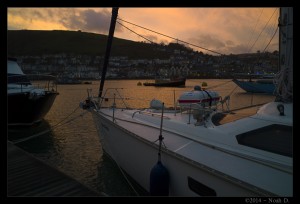 For the past few days, we’ve been reveling at the beauty of this place. Ye who hast never been outside of London has never been to England.
For the past few days, we’ve been reveling at the beauty of this place. Ye who hast never been outside of London has never been to England.
I, now, am the sailboat out at sea that is seen from Brighton, from the Portsmouth ferries, from across the twinkling hillsides of Dartmouth and Kingswear. Out of season and miles from shore, we are the sailors who are continuing on our way long after the sun goes down.
And, let me tell you… I’m not sure I understood darkness until I sailed at night for the first time. This is darkness you can feel. Even a large city on the horizon casts no glow far enough to reach Proteus. On a moonless sky, you can only see the deck of the boat and practically nothing else. Luckily, we had the moon with us crossing from Portland Bill to Dartmouth, but not so from Ramsgate rounding Dover. True darkness and miles from shore.
Ferries, I understand now, are sneaky: gigantic oceanliners, they can go from being a tiny spot on the horizon to filling your view in minutes.
But we have had some seriously good sailing days. Coming out of Brighton, we were under full sail and making great time. Also, leaving Cowes and sailing through the Needles, we almost touched 10kts over the ground with a four knot tide. Had we a little more wind, we could have easily hit double digits.
Now, we are waiting for the dreaded “Weather Bomb” to move through. It has dumped literally 50 foot waves into far northern Scotland. Some places have flashed into three digit windspeeds up north. Disgusting. But tomorrow, we will be moving on from this amazing place that we have really fallen in love with. Leave, we must.
Our clothes are clean and we are warm and fed well. The winds howl outside for a few more hours before we head farther west. Next, we are headed for Lands End and the 140nm passage in open ocean to Ireland beyond. Our time in England has drawn to a close.
For that, stay tuned…
We crossed the Prime Meridian, btw. We’ve done it dozens and dozens of times, of course, because it is in London. But this time, we sailed across… Proteus is now in The West.
Oh, and I don’t want to forget to mention: we were boarded by the Border Force! Right off Portland Bill, we saw a ship that inspired the comment: “That looks a lot like a battleship.” Well, it was a Border Force patrol boat. About that time, they launched a tender that quickly intercepted us. They boarded and we had a nice little chat, they checked all our papers, and left us in peace. Honestly, it was a rather pleasant experience and the crew was utterly professional. Of course, we had to wipe off a few heavy bootprints off the teak, but they’re doing their job and we were just passing through.
By: Noah D.
Occasionally, even the perpetual travelers must take a vacation. With my parents visiting the UK, we took the opportunity to drive up north and visit Scotland for the first time. (Well, my first time… Lynn’s second.)
Rather than a true “highland visit” we mostly visited Edinburgh. And drove much of the countryside between Ipswich and Edinburgh. Hadrian’s Wall, Newcastle’s “Angel of the North,” et al. But road trips are always a pleasure. Perhaps that’s why living in a voyaging sailboat is such an attraction: life is a perpetual road trip.
By Noah D.
I came to London the first time in 2008. Since, then I have spent quite a bit of time here: coming up on one year with nary a break.
But I was once the guy on the street corner staring at a map. I had never been to St.Paul’s or walked from the Houses of Parliament to the Tower Bridge on either side of the river. I didn’t know the difference between Leicester Square and Covent Garden and Piccadilly Circus or Oxford Circus or what happens at those different places. Less than that, I didn’t even venture a guess at what a “Shoreditch” was or the best place to exchange money.
The expat community in London is quite large. I wonder how many take a little pride when a friend visits and says: “Could you show me around?”
I assure you, it doesn’t happen in small towns very often. You usually need a purpose to visit small towns. Not that they’re not friendly, of course, but why else would you go there?
Perhaps it is even a point of pride, but being in London and being on the streets this much puts me in a position of responsibility: a position of hospitality. It is certainly not a heavy burden, per se, but it is one I take seriously. If I can help someone have a good experience in “my town” then it is up to me to give it a shot… even if it is more walking than you’ve done in weeks. 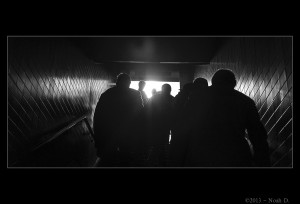
But shouldn’t that be the way of the world? Not passing each other on the street with indifference, but almost as the monks do in their hallways, blessing each other and wishing each other well in their journey. To be unrealistic, should I not wish to bless each of the throngs of holidayers clogging the exit of Tottenham Court Road station? Should I not hope to wish the Random Stoppers as they walk along in a crowd and suddenly turn around to flow upstream like a salmon to spawn?
I’m being a little idealistic, but I have to wonder: why extend hospitality and illumination to only your friends on the rare occasion they come into town when you’re around dozens and hundreds and thousands of people every day who you might just be the light in their rather dark world.
If you’re ever in town, look me up. I’d love to show you around…
###
NOTE: In the interest of full disclosure, this post originally appeared here. I post it here because of its relevance to recent events and the fact that I, too, need to listen to my own thoughts from time to time.
By Noah D.
So, in lieu of boat news at the moment–but of course that is coming along–we actually do go out and do things from time to time. Living in London, it would be an absolute shame not to explore a little of the region. In a matter of days, we decided to use a three-day-weekend wisely to the time we actually began our little excursion and we fully planned our getaway. By “planned,” I should mention, I use that term loosely: you’ll see why in a moment.
This particular time, we took a little trip to Ireland. Now I’d been to Ireland (and specifically Dublin) but this was Lynn’s first trip to the Land of Éire. Flights to Dublin from any number of the 291 airports in the London metro area cost in the £100 range per ticket. Including the cost to get out to whatever airport it might be (Heathrow costs as little as a few quid if you take the tube but the Heathrow Express from Paddington costs £20, Gatwick Express from Victoria costs £17 or so, etc) there must be a better way…
There is.
It is nice to get to sea somehow from time to time. There’s a RailSail double ticket that cost us just around £40 per person per way. The train goes from London to Holyhead in northwest Wales; then the ferry leaves from there to Dublin. The whole thing cost only £162 for the round trip for two people, taxes and such included. Certainly better than we could have done flying.
However, the cheap route comes with a little baggage. And not the rolling kind. I consider it a plus, actually, because it adds the feeling as though you’re actually traveling rather than teleporting from place to place in the metal tubes.
The first few hours after departing Euston Station in London, we stood with our stuff in the connecting area between train cars. Completely due to the fact that we were taking the train at one of the busiest parts of the week (Saturday morning at 9am), all the other travelers and commuters were on their way out of London to the north and to Wales. To fully grasp this, you must do it someday. Fifteen or twenty people with all their bags, and breakfast, and sweat, in a curved space about one meter wide and three or four meters long. But, to our advantage, we did have the bathroom inches away. Whatever advantage that might be.
We only stood or leaned or sat in this crawlspace for a little over an hour. Maybe ninety minutes. I think it was at Crewe there was a mass exodus and we got a seat for the rest of the trip. It is in these moments that people’s true nature shine. In the midst of so much calmness and resignation to the situation, there are spastic ninnies who seem to be unable to handle a bit of mild discomfort. Without giving them any more space than they deserve for now, I say to you: never be the spastic ninny.
One concern that every traveler must consider is when changing modes of transportation (for instance, rail to ferry or rail to airport) how far is one mode of transportation from the other and will there be an unforeseen middle mode of transportation. If you are traveling to France via Portsmouth Harbour, there’s a little connection to be made there that likely involves either a brisk walk or a brief taxi. Holyhead, on the other hand, requires a very brief stroll: the ferry terminal is literally inside the train station. It’s… like… a hundred meter walk.
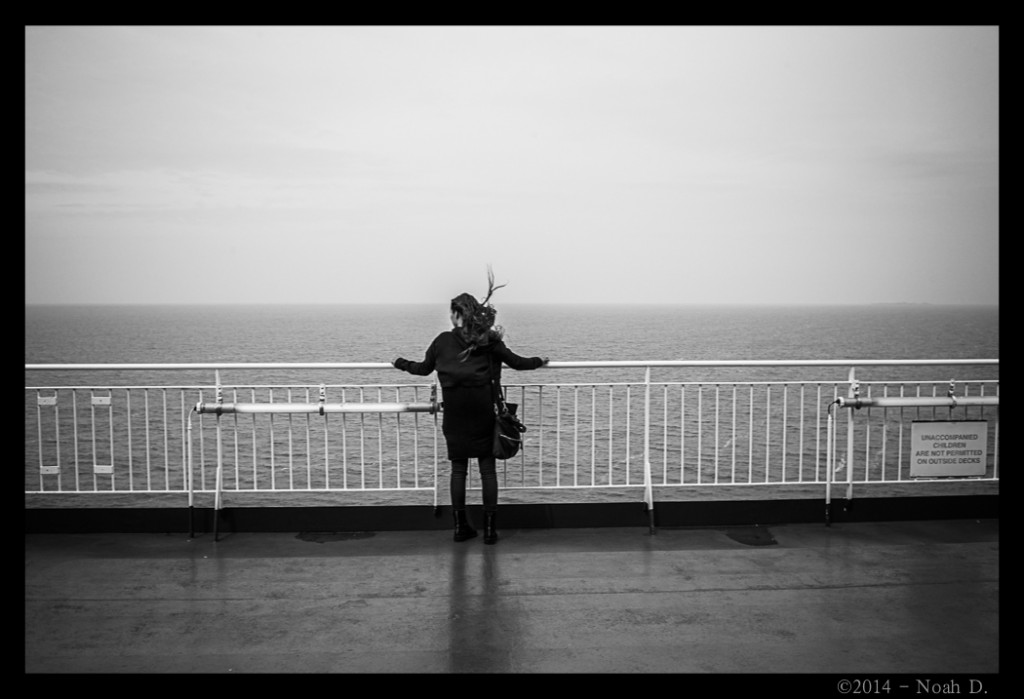 Check-in was similar to checking in to any other ferry or airline terminal. Considering we were about to go to another country–the Republic of Ireland is not part of the United Kingdom–there was surprisingly lackadaisical security. I’m not actually sure I got checked. Our bag was checked like an airport and I’m sure it was scanned eventually, but otherwise, my “personal bag” was nigh untouched.
Check-in was similar to checking in to any other ferry or airline terminal. Considering we were about to go to another country–the Republic of Ireland is not part of the United Kingdom–there was surprisingly lackadaisical security. I’m not actually sure I got checked. Our bag was checked like an airport and I’m sure it was scanned eventually, but otherwise, my “personal bag” was nigh untouched.
A brief bus trip took us directly onto the ferry. No surprises there.
The ferry itself was actually just fine. Most of these ferries are designed similarly and have the classic things most cruises have: cafeteria, a cafe, a bar/pub, a big sitting area, the outdoor areas, etc. And I’ve been on loads of ferries in my life, but this one might actually have one of the better foods I’ve had on board. Maybe I was just hungry, but I was pleasantly surprised by the non-microwaved quality of it. Kudos to you, Irish Ferries, on your realistic representation of a steak and ale pie.
Now, the next part of the story involves revealing something about my tendencies toward travel: planning is often optional. But more importantly, the use of “no plan” as part of the experience always–always!–ends up with some sort of experience worth telling. It ensures an anecdote. And here’s the one I built in for this little weekend getaway…
From the ferry terminal, we took a quick taxi to the airport to pick up a rental car. We wanted to get out of Dublin and see the countryside, and what better way to do that than to drive it. We would pick up a car and drive for a couple hours until we found a neat little town, and then find a quaint little bed-and-breakfast to settle down for the night. Of course, Ireland is famous for the astonishing number of these little bed-and-breakfasts all over the country, and why would it be any problem to find one with a vacancy?
I say, One Direction stole our beds. Or rather, their hoard stole our beds. How could we have known they were in town for a multi-day concert series and pretty much every bed in a 50 mile radius of the concert was taken! By the time we started looking, we were almost an hour outside Dublin. It took every bit of the next two hours to find a bed-and-breakfast with a vacancy by stopping at every place that looked occupied. Proof, again, that there are lovely people everywhere in the world… even at random, tiny pubs in the narrow roads of County Meath. Or perhaps I should say especially at random, tiny pubs in the narrow roads of County Meath: explaining our situation, the proprietor and few patrons at the bar started pitching in ideas and making calls. A few minutes later, we had lodging at the Isaac’s Well in Clonmellon in County Westmeath.
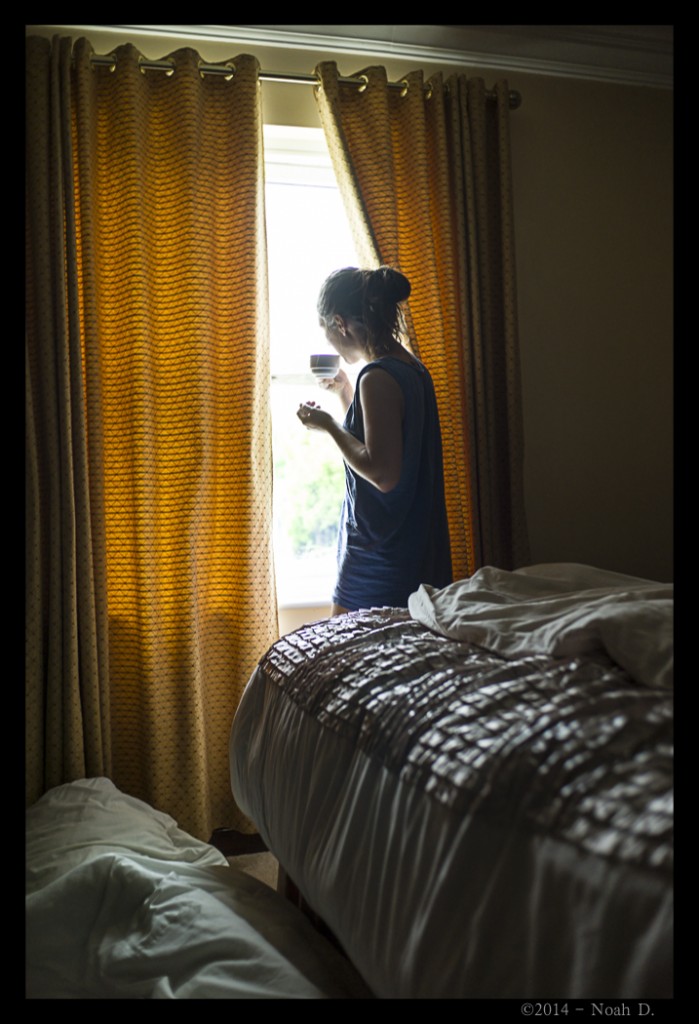 The landlady had just had surgery and could not provide us with the “breakfast” part of the bed-and-breakfast, but the accommodations were actually spectacular. Everything seemed fresh and new and the huge room and bathroom actually sparked the conversation: “What if we just stay here all weekend?”
The landlady had just had surgery and could not provide us with the “breakfast” part of the bed-and-breakfast, but the accommodations were actually spectacular. Everything seemed fresh and new and the huge room and bathroom actually sparked the conversation: “What if we just stay here all weekend?”
And for €35, definitely not bad.
Oh, and about the money: The next morning was Sunday. We started looking for someone to check out, leave the key and pay for the room. There was no proper desk, of course, and the barman had just tossed us a key the previous night… and the bar was closed. Honor system it is, then! We left the money and the key on the table in the room and departed…
Oh, and one last thing before leaving this area of Ireland: if you’re ever near Kells, pop into the Keltic Bar by the Headford Arms Hotel (also full of One Directioners, btw). The kitchen had been closed a few minutes by the time we arrived, but the staff sat us down by the fire and went to get the cook who had just left. I’m not sure I’ve had this happen to me anywhere else in the world.
So… driving the countryside of Ireland now, we loaded up on road trip snacks and headed west. The internets say that Ireland is approximately the same size as the state of Indiana, so it takes just a couple of hours to drive all the way across it. Especially considering they’ve got a serious highway system that makes travel across the country pretty straightforward and fast. We made it all the way across the country to Galway long before lunch. To the north to the wilds of Connemara or to the south to Doolin and Dingle and the Cliffs of Moher and all those places people tend to find themselves while backpacking Europe.
We worked our way northwest. This area is just really brilliant. Really beautiful and craggy landscape. The grass and trees seem lightly laid on top of some ancient world, like the moss that sits just on top of rocks. The whole world could be peeled away.
You’ll notice, Lynn is making most of these photos. I was driving. It isn’t a forgiving road.
Having just come back from an assignment in the Republic of Georgia, I took an interest in the sheep. The sheep are completely different here than the ones in Georgia. (But that story is for another time.)
Traveling like this is a bit of a risk at times. For the person with their face in a guidebook, they probably won’t ever miss all the big stuff that we might have driven right past. But we still do okay, I think. Anything missed, we just have to come back and hit next time… but we don’t miss much.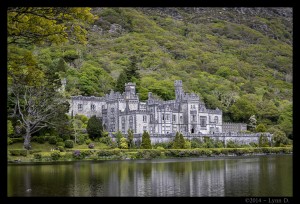
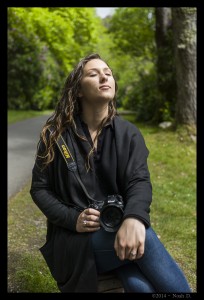 Like the relatively insane Kylemore Abbey, for instance. If you’re randomly traveling through this sort of terrain and this thing pops up in the distance, you kinda go see what’s up. Turns out, it was one of the most elaborate and lavish estates in the British Isles. Even Kings have looked to it as a getaway home, but one famously decided against it citing the fact that even a king couldn’t afford such grandeur.
Like the relatively insane Kylemore Abbey, for instance. If you’re randomly traveling through this sort of terrain and this thing pops up in the distance, you kinda go see what’s up. Turns out, it was one of the most elaborate and lavish estates in the British Isles. Even Kings have looked to it as a getaway home, but one famously decided against it citing the fact that even a king couldn’t afford such grandeur.
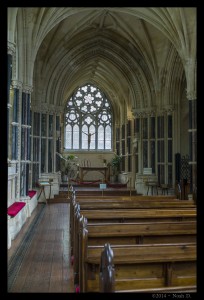 The story of the palace is legendary in the area and I dare not spoil it for you here. Best to visit and savor it all for yourself.
The story of the palace is legendary in the area and I dare not spoil it for you here. Best to visit and savor it all for yourself.
Now well into the afternoon, we must continue on.
Driving down the coast of Connemara, the landscape changed again. The huge hills (or “bens”) continued, but the coastline changed everything. Thatch-roof, stone cottages and a narrow road winding amongst ancient rock walls that end in the sea… I love unconventional landscapes and this was certainly one of them.
Returning to Dublin was quick. As much of a shame as it was to leave the brilliant countryside, we needed to get the car back to the airport.
Which brings up another topic: car rentals.
I though it would be nice to give the local company a shot instead of going with the huge giants like Hertz or Avis or Sixt. Well… I’m not sure I’ll be doing that again anytime soon. Found online on a typical travel site, it was the cheapest. But to get the same level of car, insurance, and GPS unit, we got our clock cleaned. I mean, properly reamed.
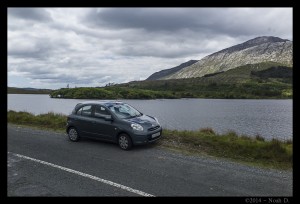 The dorky little car was a champ and actually moderately fun to drive on these crazy narrow roads, but the rental company (which I have intentionally neglected to mention) left a lot to be desired. Especially in the “hidden fee” category.
The dorky little car was a champ and actually moderately fun to drive on these crazy narrow roads, but the rental company (which I have intentionally neglected to mention) left a lot to be desired. Especially in the “hidden fee” category.
Looking back at it now, I probably should have known better, but what’s done is done. And why didn’t I just say “forget it” at the check-in desk instead of going through with it? Because unless you cancel within 24hrs of the booking, you gotta pay for the first day. Yep, ya got me, friend. Shame on me.
Not really the feeling you want to go away with, is it…?
Anyways, all that aside, the rest of the trip (post-credit card melt-down) was just fine. Dublin is a neat little town. It is manageable and can be walked across in a really short amount of time. Most of the sites can be seen in a single day.
What is worth visiting? I’d say the Jameson Distillery or the Guinness Storehouse should be on the top of your list. Even if you aren’t interested in the libations, these–along with similar places like the Jack Daniels Distillery in Lynchburg, TN–are single-theme museums that do one thing really well: tell you how a very specific product is created from start to finish. Where some museums spread themselves too thin, these types of educational tours break down a process and show you how something is done. And they do it around all the original equipment. There’s a fair amount of propaganda, but what do you expect: that said, the tour staff are cute and funny about that fact, interacting with their groups and keep it from being boring. And, of course, there are taste-testing moments throughout… which means you’re actually getting a little more for your money than the average walk-through museum.
See also? The Kilmainham Gaol (pronounced “jail”) and the Zoo are usually biggies on the tourist map. The Dublin Castle might be worth poking your head into, but it costs a bit and I’m not sure everybody gets their kicks in such places (loads of local history… and… not much else). Other things to stop by might be Trinity College or the National Museums and the famous churches (like St.Patrick’s).
Public transportation is really easy to figure out and it covers most of the town, but I don’t think we used it much: it is so easy to walk around.
One thing that I did when I visited previously: I took the hop-on-hop-off bus tour and saw pretty much everything worth seeing in the town in a single afternoon. It was so simple and I remember it being shockingly cheap back in 2008. When I looked at the prices this time, I was a little disappointed that it had jumped so high (in the €20 per person range). Such is the way of things…
Undeniably, the pub culture is alive and well. Pay attention to which tourist map you pick up because there is actually one that is the Nightlife Edition, marking every pub, nightclub, and bar in central Dublin. It doesn’t do much for you if that’s not your thing, but…
We stayed at the Fleet Street Hotel right there at the Temple Bar. Pretty solid hotel and there was no beating the location. Here’s the trick, though: the original purpose of staying outside of Dublin the first night was driven by the fact that I noticed that Friday night or Saturday night hotel bookings in the city were astronomical. Serious sticker shock. It turned out this was entirely driven by One Direction masses. And the hotels made bank.
“It couldn’t have been that much of a difference…” you say? Oh…
Here’s an example: I (unscientifically) found the average Friday and Saturday night bookings in a central Dublin hotel costing around €200-€250 per night. On Sunday night, the exact same hotel dropped to €80. By Monday: €65. For one night, it would have cost us more than what we spent for our whole two night stay (since we stayed Sunday night through Tuesday morning).
I mean, I don’t blame them. If screaming fans are going to pay ridiculous prices to see this year’s fad pop band, they’re also going to fork out the cash for the hotel in which to swoon in post-ecstatic fervor. But, we’re also not going to pay that. Pay attention, travelers, to who or what is going on in town.
The return trip was a bit exhausting, by the way. I’m sure they have their reasons, but our only option on the return (at this price category) was to be up all night. The travel consisted of the ferry trip across the Irish Sea to Holyhead, a lengthy wee-hour vigil in the Holyhead train station, and then the last little jaunt back into London. We arrived at Euston during the eight o’clock hour, just in time for a little nap and Lynn getting to work at noon.
No biggie. As intense as sitting up in a train station from 2am-4:45am might sound, it really is about par for the course when traveling… pretty much anywhere. Yes, it is fully possible to treat travel just like a trip to Disney World complete with normal waking hours and almost luxurious accommodations. Traveling like that requires, believe it or not, vast amounts of money. The rail, airlines, and hotels know this. Just like they know people will fork our thousands of $/€/£ for a weekend at a concert, the prices reflect this. On the other hand, there are times and routes that don’t require a huge pocketbook because, at the same time that the travel companies jack up the prices when it is obvious they corner the market, the same companies will have wildly lower-cost travel options, too. Which means it is fully possible to travel on a budget, you just have to realize that there are sacrifices to be made in the name of comfort.
Basically that’s all it is: comfort. You’ll still get there, but you might have to stand part of the way. You’ll still get there, but you might have to stay up late at night. You’ll still get there, but you’ll have to take just a little bit longer to get there. And, you’ll also have somewhere to stay, whether you have to make your own bed up and bathe in a community shower, that’s part of the trade-off for cheapness.
If I make a concession, I usually err on the side of a little more money for accommodations. Travel from place to place doesn’t need to be that comfortable and I can stay up late. But I kinda like my own space, moderate privacy, and know that my stuff isn’t going to be stolen when I leave it in the room to see the sights.
So there… Dublin.
By Noah
Twenty-four hours after this pair of photographs were taken, I experienced the most difficult night of my life. And, though that might sound like an inflated statement, here’s a little of the circumstances surrounding this photograph:
My friend, Philip, and I–both photojournalists–were working on a project with the shepherds in the southeastern Caucasus. This particular evening in Georgia, we were in the lowlands awaiting our hosts: shepherds of the arid Samoukhi region in the far southeast tip of Georgia. This beautiful location (exactly here) is final staging ground for shepherds who will make the hard push up and over the Abano Pass into the summer grazing grounds.
This particular night of relative comfort–due to the tent–was followed by hiking approximately 20 miles from 1500ft to 9500ft the next day… at which point we were in conditions too bad and too urgent for the tent, so we “slept” in every piece of clothing we owned (including our coats)… inside a sleeping bag… under our rain cloaks… surrounded by all our gear… rolled in a blue tarpaulin.
Now, that wouldn’t be so bad, except the fact that outside our little blue burritos were about 6000 sheep, goats, cows, and horses. At this point, none of us–not even the shepherds–had eaten much other than vodka-soaked bread and some canned tuna (I think it was?) and half-way wild onions for the last 36 hours. This was the danger of this trek at this time of year: all the livestock are pushed hard because there is nothing to eat above the tree-line.
I mention the hunger issue not to make you pity us, but pity the sheep and the fact that I was nibbled and stepped on countless times during the night. Somewhere around 3am, I was nibbled on and whatever-it-was pinched the skin of my shoulder… so, I punched it through the many layers. The satisfaction of clocking a random animal in the middle of the night was short-lived…
The conditions were complete misery. For the few minutes of sleep I might have gotten, I spent most of the time shivering and soaking wet. It had been “raining” lightly as we lay down; however, I think it was just pervasive clouds. And to tell you how pervasive was the water… everything–literally everything–was wet. Every layer of the 5 or 6 that I had on was wet. Even under my back, which was inside the sleeping bag all night. The only thing that was not wet was the contents of a $10 oversized dry bag that my cameras and notebooks were inside and I had been very careful not to open it.
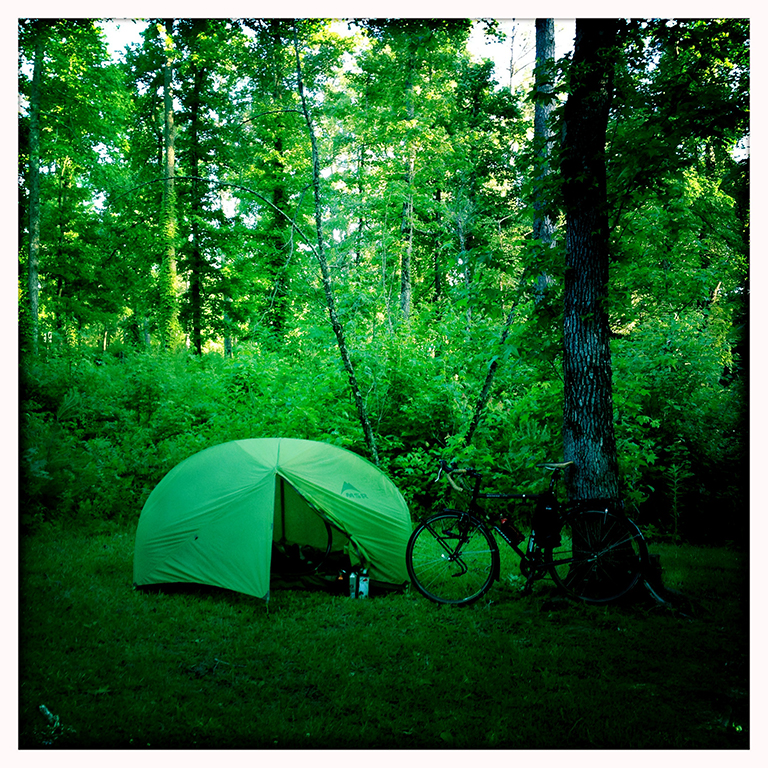 What a strange way to start a review of a tent: a night in the most miserable conditions I’ve ever experienced and I didn’t even put up the tent! I give you this little anecdote because that is the situations in which I have no problem taking this tent. Even though the situation did not allow for it to be set up this time, it would have handled it, I have no doubt.
What a strange way to start a review of a tent: a night in the most miserable conditions I’ve ever experienced and I didn’t even put up the tent! I give you this little anecdote because that is the situations in which I have no problem taking this tent. Even though the situation did not allow for it to be set up this time, it would have handled it, I have no doubt.
Rewind one year to the first time I ever used the tent for an extended period of time:
I rather consider it a shakedown cruise of my equipment and myself. For eight days, I bicycled from Nashville, Tennessee, to Natchez, Mississippi: the entire length of the Natchez Trace. For 444 miles over eight days I lived on a Jamis Aurora Elite expedition bike and lived in the MSR Hubba Hubba NX Tent.
The 2014 version of this tent has been redesigned, but my copy–the 2013 version–I actually slightly prefer due entirely because it is green. (Though it is a tough find these days.) I wouldn’t have thought much of this until I saw it in action. One hazard of wild camping–especially certain places in the world–is being bothered by people. The tent, though kind of lime green, blends in well with the environment. The new version, however, is all red and grey… certainly a little more stylish, but a bit less natural colors.
One thing that I do recommend with this tent is the proper MSR Tent Footprint that is built for it.
Now, why is discussing a tent relevant for a sailing site? One of the coolest things I’ve seen people do while sailing routes like the Great Loop is to actually get out of the boat and camp along the way.
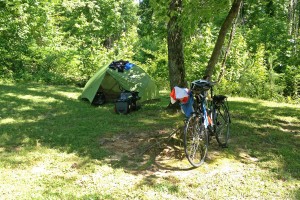 This tent can put up with some of the most ridiculous conditions I’ve thrown at it. But don’t think that means it is difficult to set up or break down. It literally sets up in 7 or 8 minutes and, from the experience of the morning after the top photo was taken, it can be broken down in perhaps 60 seconds. Most importantly, footprint, structure, and rain fly packs down to the size of an American football (maybe a fraction larger) and weighs much less. I can pack it into luggage for international assignments and I don’t have to sacrifice too much else.
This tent can put up with some of the most ridiculous conditions I’ve thrown at it. But don’t think that means it is difficult to set up or break down. It literally sets up in 7 or 8 minutes and, from the experience of the morning after the top photo was taken, it can be broken down in perhaps 60 seconds. Most importantly, footprint, structure, and rain fly packs down to the size of an American football (maybe a fraction larger) and weighs much less. I can pack it into luggage for international assignments and I don’t have to sacrifice too much else.
The tent is also spectacularly designed. Having spent weeks and weeks worth of time in this tent, I’ve never felt a drip on the inside that I didn’t inadvertently bring in. The design extends to the rope-free set-up. The tent pegs are really perfectly designed to hold each corner and the rainfly without fuss. I’ve been in a few storms with (Force 3-4) wind and I haven’t worried about it at all.
Don’t expect it to keep you too warm, but shockingly, the interior of the tent says warmer than I expected considering how breathable the material actually is.
The Hubba Hubba (two Hubba’s) version says “2-person.” Yeah, that is true. But you probably need to be quite good friends with them. I used it as a 1-person tent while on the Natchez Trace and kept all my equipment inside. With two people, the only space you have is for lying down. The rainfly extension becomes the gear shed, which the footprint does not extend to… meaning, if it rains, water will be running under your gear… or shoes.
It also has only a very small little pocket on either end for storage. It really might not matter very much to some people, but I could see how this Gear Loft could be a nice addition.
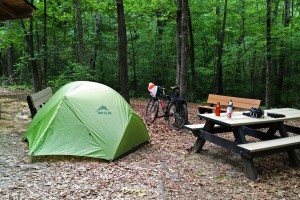 Would I buy it again? Absolutely. It is not the biggest tent in the world (far from it) but it is perfect for extended living in rough conditions. MSR (Cascade Designs) have constructed a serious tent and not wasted anything while not stripping it down too far.
Would I buy it again? Absolutely. It is not the biggest tent in the world (far from it) but it is perfect for extended living in rough conditions. MSR (Cascade Designs) have constructed a serious tent and not wasted anything while not stripping it down too far.
Is it a perfect tent to keep aboard a boat? Yes. Put it in a little out-of-the-way compartment. And when you need to take it to shore in your tender, you won’t even know it is on the boat.
Though my comments and opinions about the tent itself are entirely my own and generated from real-world use, the links I post that open to Amazon are actually part of an Amazon Associates program. If you are in the market for these products, please click through and purchase them by my referral. It costs you nothing extra and I get a percentage of the sale cost:
MSR Hubba Hubba NX Tent
MSR Hubba Hubba Tent Footprint
MSR Universal Gear Loft
###